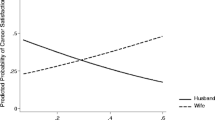Abstract
Qualitative research has investigated distinct couple types that divide work and family responsibilities based on employment circumstances and relationship characteristics, but such research is not conducive to identifying frequencies of couple types or statistically comparing work-family circumstances across couple types. The current study incorporated both employment and family variables in identifying four distinct dual-earner couple types among respondents from the National Survey of the Changing Workforce. Couple types were compared regarding demographic information, and memberships in couple types were predicted based on this information. Some significant differences emerged that may begin to explain the circumstances and motivations behind selecting certain work-family arrangements, though the more peer-like couples were less distinct and in some ways less economically advantaged than expected.

Similar content being viewed by others
References
Abroms, L. C., & Goldschneider, F. K. (2002). More work for mother: How spouses, cohabiting partners and relatives affect the hours mothers work. Journal of Family and Economic Issues, 23, 147–166.
Aldenderfer, M. S., & Blashfield, R. K. (1984). Cluster analysis. Beverly Hills, CA: Sage.
Bond, J. T., Galinsky, E., & Swanberg, J. E. (1998). The 1997 national study of the changing workforce. New York: Families and Work Institute.
Clarkberg, M., & Moen, P. (2001). Understanding the time squeeze: Married couples’ preferred and actual work-hour strategies. American Behavioral Scientist, 44, 1115–1136.
Cobb, L. A., Seery, B. L., & McKinney, K. (2004). College students’ perceptions of employment-based marital dyad types. Journal of Family and Economic Issues, 24, 203–224.
Crouter, A. C., & Manke, B. (1997). Development of a typology of dual-earner families: A window into differences between and within families in relationships, roles, and activities. Journal of Family Psychology, 11, 62–75.
Deutsch, F. M. (1999). Halving it all: How equally shared parenting works. Cambridge, MA: Harvard University Press.
Doumas, D. M., Margolin, G., & John, R. S. (2008). Spillover patterns in single-earner couples: Work, self-care, and the marital relationship. Journal of Family and Economic Issues, 29, 55–73.
Flouri, E., & Buchanan, A. (2002). Childhood predictors of labor force participation in adult life. Journal of Family and Economic Issues, 23, 101–120.
Gager, C. T., & Hohmann-Marriott, B. (2006). Distributive justice in the household: A comparison of alternative theoretical models. Marriage and Family Review, 40, 5–42.
Golden, L. (2008). Limited access: Disparities in flexible work schedules and work-at-home. Journal of Family and Economic Issues, 29, 86–109.
Haddock, S. A., Zimmerman, T. S., Ziemba, S. J., & Lyness, K. P. (2006). Practices of dual earner couples successfully balancing work and family. Journal of Family and Economic Issues, 27, 207–234.
Hartigan, J. A. (1975). Clustering algorithms. New York: Wiley.
Hill, E. J., Martinson, V. K., Ferris, M., & Baker, R. Z. (2004). Beyond the mommy track: The influence of new-concept part-time work for professional women on work and family. Journal of Family and Economic Issues, 25, 121–136.
Hochschild, A. (1989). The second shift. New York: Avon Books.
Johnson, M. P., Huston, T. L., Gaines, S. O., & Levinger, G. (1992). Patterns of married life among young couples. Journal of Social and Personal Relationships, 9, 343–364.
Keith, P. M., & Shafer, R. B. (1998). Marital types and quality of life: A reexamination of a typology. Marriage and Family Review, 27, 19–35.
Lee, Y., & Waite, L. J. (2005). Husbands’ and wives’ time spent on housework: A comparison of measures. Journal of Marriage and Family, 67, 328–336.
Lewis, S., Kagan, C., Heaton, P., & Cranshaw, M. (1999). Economic and psychological benefit from employment: The experiences and perspective of mother of disabled children. Disability & Society, 14, 561–575.
Monna, B., & Gauthier, A. H. (2008). A review of the literature on the social and economic determinants of parental time. Journal of Family and Economic Issues, 29, 634–653.
Murasko, J. E. (2008). Married women’s labor supply and spousal health insurance coverage in the United States: Results from panel data. Journal of Family and Economic Issues, 29, 391–406.
O’Hara, B. (2004). Do mothers work to support ailing husbands? Journal of Family and Economic Issues, 25, 179–198.
Perry-Jenkins, M., Seery, B., & Crouter, A. C. (1992). Linkages between women’s provider-role attitudes, psychological well-being, and family relationships. Psychology of Women Quarterly, 16, 311–329.
Pimlott-Kubiak, S., & Cortina, L. M. (2003). Gender, victimization, and outcomes: Reconceptualizing risk. Journal of Consulting and Clinical Psychology, 71, 528–539.
Pleck, J. (1997). Paternal involvement: Levels, sources, and consequences. In M. Lamb (Ed.), The role of the father in child development (pp. 66–103). New York: Wiley.
Rachlin, V. C. (1987). Fair vs. equal role relations in dual-career and dual-earner families: Implications for family interventions. Family Relations, 36, 187–192.
Raley, S. B., Mattingly, M. J., & Bianchi, S. M. (2006). How dual are dual-income couples? Documenting change from 1970 to 2001. Journal of Marriage and Family, 68, 11–28.
Risman, B. J., & Johnson-Sumerford, D. (1998). Doing it fairly: A study of postgender marriages. Journal of Marriage and the Family, 60, 23–40.
Schwartz, P. (1994). Peer marriage: How love between equals really works. New York: The Free Press.
Sheppard, B. H., Hartwick, J., & Warshaw, P. R. (1988). The theory of reasoned action: A meta-analysis of past research. Journal of Consumer Research, 15, 325–343.
Still, M. C. (2006). The opt-out revolution in the United States: Implications for modern organizations. Managerial & Decision Economics, 27, 159–171.
Wallace, J. E. (2008). Parenthood and commitment to the legal profession: Are mothers less committed than fathers? Journal of Family and Economic Issues, 29, 478–495.
White-Means, S., & Chollet, D. (1997). Opportunity wages and workforce adjustments: Understanding the cost of in-home elder care. Journal of Gerontological Social Science, 51, 82–90.
Author information
Authors and Affiliations
Corresponding author
Rights and permissions
About this article
Cite this article
Hall, S.S., MacDermid, S.M. A Typology of Dual Earner Marriages Based on Work and Family Arrangements. J Fam Econ Iss 30, 215–225 (2009). https://doi.org/10.1007/s10834-009-9156-9
Published:
Issue Date:
DOI: https://doi.org/10.1007/s10834-009-9156-9




